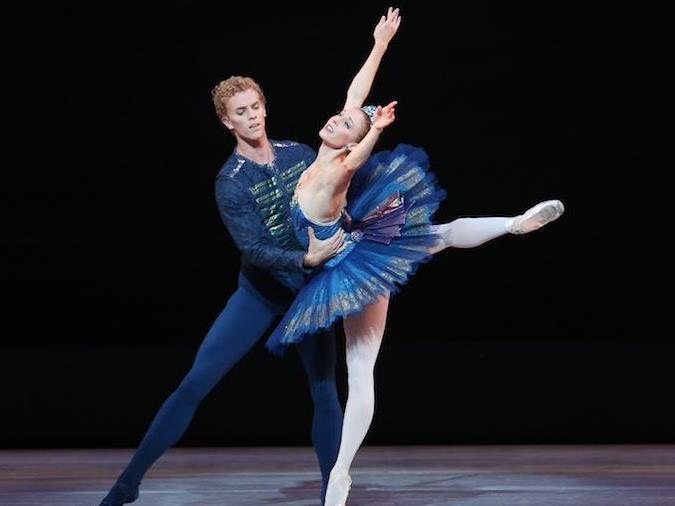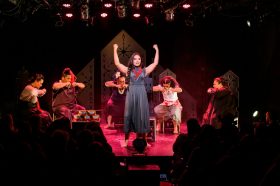Australian Ballet’s Imperial Suite introduces two classical works in quite different, yet similar, styles: Balanchine’s Ballet Imperial, revealing his Petipa background and influences and the elegant Suite En Blanc by Serge Lifar, redolent of the French school are combined in the program.
Balanchine’s Ballet Imperial (1941) is steeped in his Imperial Russian /Tsarist roots and is a homage to Petipa. For this work, the front curtain is the imposing golden Imperial Russian crest. You can see the Petipa/Ivanov influence in the use of repetition, particular lines for the ensemble and how some of the choreography is similar to that of Swan Lake and the Bluebird pas de deux from Sleeping Beauty for example (Adam Bull’s dazzling solo).
There were also possible allusions to La Bayadere. There have been several versions of this work, in this one it is presented (freshly designed by Hugh Coleman) in gorgeously opulent tutus for the women and a uniform-like outfit for the men (harking back to the pre-WW1 outfits worn by Marinsky students). The overwhelmingly dominant colour is blue.
Miwako Kubota featured in a glittering solo and pas de deux. Adam Bull and Lana Turner are tremendous in their thrilling pas de deux, very sensitively performed to the luscious lyrical Tchaikovsky music. However, while most impressively performed, I felt this work seemed somewhat dated. The dancers generally performed with a neutral expression and there was no real emotional engagement with the audience (I guess they were concentrating on the difficult counts and rhythms).Tchaikovsky’s piano concerto was delicately, fabulously played by soloist Hoang Pham and glowingly supported by the orchestra under the enthusiastic baton of Nicolette Fraillon.
When the curtain rose on Lifar’s Suite En Blanc (1943), there was an audible murmur of appreciation. The dancers are frozen in tableaux, all in white, the women in either the long Romantic tutu or the more revealing classical one, the men in black and white like the poet in ‘Les Sylphides’. There is a very simple yet effective set of steps and a raised platform.
The lyrical, hypnotic score of nineteenth-century composer Edouard Lalo, which is heavily accented with horns and percussion, has almost annoyingly catchy and delightfully danceable melodies.Technically, this is a very demanding bravura showcase for the dancers in assorted ensembles, trios, pas de deux etc. It is extremely revealing- any wrong step is glaringly obvious. Lifar himself was involved in the staging of this for the Australian Ballet when he visited in 1981. Lifar’s choreography, like Balanchine’s later, pushes and pulls strictly classical movements off-balance and adds variations on a theme and character development to a degree.
We can also see, as another of my colleagues has observed and is most appropriate to the period, nineteenth-century modernism’s fascination with all things oriental, especially in Lifar’s favourite frieze-like movement motif reminiscent of ancient Greek art, which appears often, particularly in the elegant struts on and off stage and the way the arms are held at times. Special mention must be made of Chengwu Guo in the fiery Mazurka with its showy jumps and turns. Three Sylph-like figures (Natasha Kusen, Robyn Hendricks and Valerie Tereshchenko ) are enchanting in La Sieste. Amber Scott is dazzling and assured in the ‘Flute’ variation while Laura Tong is magnificent in the ‘Cigarette’ solo (which former Australian Ballet head Marina Gielgud danced in Paris at the age of 15, coached by Lifar).The grand pas de deux is performed by Amber Scott and Rudy Hawkes with elegance and grace .
A dazzling, delightful evening.
Rating: 4 out of 5 starsBallet Imperial
Conductor: Nicolette Fraillon
Lana Jones
Adam Bull
Miwako Kubota
Suite en Blanc
Conductor: Nicolette Fraillon
La Sieste: Natasha Kusen, Robyn Hendricks and Valerie Tereshchenko
Pas de Trois: Madeleine Eastoe, Andrew Killian and Kevin Jackson
Serenade: Reiko Hombo
Pas de Cinque: Ako Kondo
Cigarette: Laura Tong
Mazurka: Chengwu Guo
Pas de Deux: Amber Scott and Rudy Hawkes
Flute: Amber Scott
Joan Sutherland Auditorium, Sydney Opera House, Bennelong Point
www.australianballet.com.au
10 – 17 May
State Theatre, Arts Centre, St Kilda Rd
20 – 28 June





